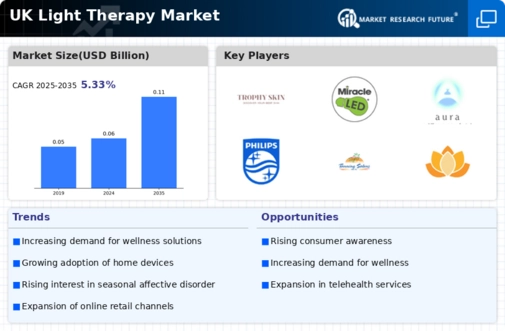The light therapy market exhibits a dynamic competitive landscape, characterized by a blend of innovation and strategic positioning among key players. Companies such as Philips (NL), Lumie (GB), and Verilux (US) are at the forefront, leveraging their technological expertise to enhance product offerings. Philips (NL) focuses on integrating advanced LED technology into its light therapy devices, aiming to improve user experience and efficacy. Meanwhile, Lumie (GB) emphasizes a strong commitment to research and development, which allows it to introduce novel solutions tailored to specific health needs. Verilux (US) appears to be concentrating on expanding its product line to cater to a broader audience, thereby enhancing its market presence. Collectively, these strategies contribute to a competitive environment that is increasingly driven by innovation and consumer-centric approaches.
Key business tactics within the market include localizing manufacturing and optimizing supply chains to enhance efficiency and reduce costs. The competitive structure of the light therapy market is moderately fragmented, with several players vying for market share. This fragmentation allows for diverse product offerings and fosters competition, compelling companies to continuously innovate and refine their strategies to maintain relevance.
In October 2025, Philips (NL) announced a partnership with a leading health technology firm to develop a new line of smart light therapy devices that integrate AI capabilities. This strategic move is likely to position Philips at the cutting edge of the market, as it combines traditional light therapy with modern technology, potentially enhancing treatment outcomes for users. The integration of AI could also facilitate personalized therapy sessions, thereby increasing user engagement and satisfaction.
In September 2025, Lumie (GB) launched a new product line specifically designed for seasonal affective disorder (SAD), which includes a range of light boxes that utilize full-spectrum light. This initiative not only reinforces Lumie's commitment to addressing specific health concerns but also strengthens its brand identity as a leader in the light therapy sector. The targeted approach may attract a dedicated customer base seeking effective solutions for SAD, thereby enhancing market share.
In August 2025, Verilux (US) expanded its distribution network by entering into agreements with several major retailers across the UK. This strategic expansion is indicative of Verilux's intent to increase accessibility to its products, potentially driving sales growth. By enhancing its retail presence, Verilux may also benefit from increased brand visibility and consumer trust, which are crucial in a competitive market.
As of November 2025, current trends in the light therapy market are increasingly defined by digitalization, sustainability, and the integration of AI technologies. Strategic alliances among companies are shaping the landscape, fostering innovation and collaborative development. The competitive differentiation is likely to evolve from traditional price-based competition towards a focus on technological advancements, product innovation, and supply chain reliability. This shift suggests that companies that prioritize these aspects may gain a competitive edge in the increasingly sophisticated light therapy market.























Leave a Comment